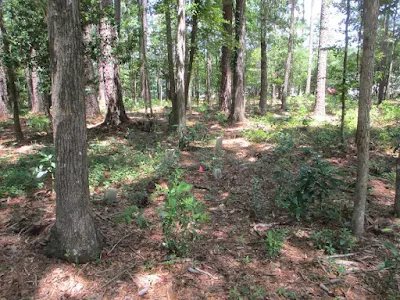 |
| Mr. Kevin Mishoe and SC Division Commander Jamie Graham who helped arrange the Eddy Lake Cemetery Cleanup. |
Greetings and Salutation, Y'all!
At one time during the second half of the 19th Century, the area now known as Bucksport was formally known as Bucks Township Bucksville was the third largest port in South Carolina. Bucksport was part of the mill on the Waccamaw River that built the clipper ship Henrietta, the largest wooden ship ever constructed in South Carolina. That ship was launched from Bucksville on Thursday, April 29, 1875. Eddy Lake was part of that area and was reportedly where many of people who worked at the mill lived.
Bucksport was named for its founder, Mr. Henry Buck of Maine who settled in South Carolina in 1828.
Henry Lee Buck, Sr. was the middle son of Henry Buck and the older brother of George Olney Buck and the half-brother of
William L. Buck -- who would later inherit their father's lumber mill after the War Between The States.
He was mustered into Confederate service on
On Saturday, March 25, 1865, Henry was captured by Union troops while bearing the regimental flag in advance of Fort Steadman and beyond the captured lines during the final stages of the Siege of Petersburg, Virginia. The color-bearer, Private Samuel J. Reid, had been knocked down by the explosion of a shell and the colors were taken up by Captain Buck. He was captured in the battle and then sent to Old Capital Prison in Washington, D.C. on Monday, March 27, 1865 then later moved to Fort Delaware, on Pea Patch Island in the Delaware River where he finished out the last month of the war.
Finding Eddy Lake Cemetery can be attributed to Miss Mary Ann Owens, a longtime Bucksport resident and self-proclaimed historian for the community. Her search for the long lost cemetery where her great-great grandparents are buried lead to the remarkable uncovering of centuries of Horry County history.
As a child she heard stories about the Eddy Lake Cemetery but no one could ever tell her where it was located. For decades, memories shared of Eddy Lake Cemetery started to become more like folklore.
"As a young girl growing up in this area, I often listened to what elder people were talking about. As matter of fact, I would go to their porch and sit on the edge of their porch just so I could hear what they were talking about," said Owens. "Often they would talk about Eddy Lake and how their parents worked at the sawmill."
She knew that her grandparents were both buried there and she made it her mission to locate the cemetery. The
cemetery itself was largely unknown to many people, and it stood tucked
away behind the Grand Strand Water and Sewer plant near Bucksport. A recent road construction project stirred up the urgent need to find the cemetery, located off Bucksport Road.
There are only 23 visible headstones, but dozens of indentations and depressions in the ground indicate that there are others without headstones who were buried in homemade wooden boxes with their graves marked by things like conch shells and farm implements.
Owens turned to Mr. Kevin Mishoe, a local educator, to help her launch a major effort to reclaim the cemetery.
Their first move was to contact Grand Strand Water and Sewer whose officials quickly gave them the okay to move forward. Workers with Horry County Planning and Zoning were instrumental in helping identify some of the sites, marking them with orange flags. Horry County Councilman Orton Bellamy has also become involved in the project, working on an historical marker for the site.
They are sure that at least one of the graves dates back to 1887, but they aren’t sure if there are some that are older.
In order to receive help from historic preservation organizations and archaeologists, Mishoe said the community first needs to clear and remove the initial brush and debris at the site. He set up a GoFundMe page set up to raise funds for the project.
However, the efforts were proving slow and local interest in helping with the project was disappointing low.
Mishoe was then contacted by Mr. Jamie Graham, president of the South Carolina Division Sons of Confederate Veterans, an an old high school friend. Graham volunteered his help and those of the SCV because its members realize that Bucksport isn’t a rich community and he knew they were having trouble trying to raise enough money for the cleanup and renovation.
In addition to volunteers from the 7th Brigade -- largely from members of the Horry Rough And Readys Camp #1026 -- were volunteers from the Horry County Police Department also pitched in to help with the cleanup of the cemetery and reclaim it from the woods. Mr. Mishoe's son is a Horry County police officer and helped pitch the idea to his coworkers.
Mishoe himself was one of the volunteers who helped with the clean up. Graham, who has significant expertise in grave stone restoration, was able to repair several of the stones that were broken and crumbling from age.
Eddy Lake Cemetery is now on the historic register, and with permission from Grand Strand Water & Sewer Authority, the cemetery was recovered and restored.
The following are photographs taken of the cleanup of Eddy Lake Cemetery.








 |
| Before the cleanup. |

 |
| After the cleanup. |


 |
| A special thanks to all those who came together to help make this noble endeavor possible. Well done, y'all! |
This is why I am proud to call myself a member of the South Carolina Division Sons of Confederate Veterans, and why I continue to support their efforts in honoring all of our Southern history.
To learn more about the SC SCV and what they do please check out the link on the main page.
Y'all have a wonderful Dixie day folks!



































































